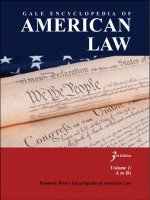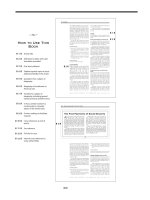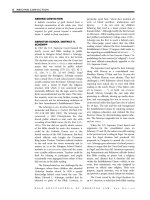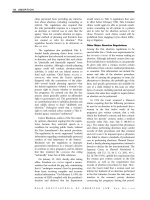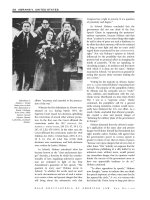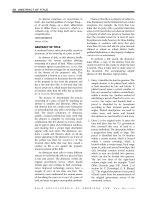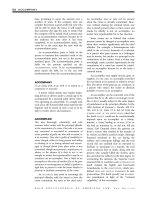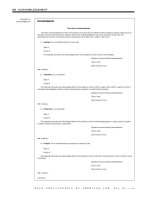Gale Encyclopedia Of American Law 3Rd Edition Volume 1 P25 docx
Bạn đang xem bản rút gọn của tài liệu. Xem và tải ngay bản đầy đủ của tài liệu tại đây (224.15 KB, 10 trang )
highly specialized. Their levels are set as percentages
of the worldwide maximum of 140,000.
First preference: Priority workers are allotted
28.6 percent. These are persons of “extraor-
dinary ability” in the sciences, arts, education,
business, or athletics; outstanding professors
and researchers; and multinational execu-
tives and managers.
Second preference: Professionals holding ad-
vanced degrees or persons of exceptional
ability in the sciences, arts, or business are
allotted 28.6 percent.
Third preference: Skilled workers in short supply,
professionals holding baccalaureate degrees,
and other workers in short supply are allotted
28.6 percent.
Fourth preference: Certain special immigrants:
7.1 percent. These are mainly religious work-
ers, as well as former employees of the U.S.
government and international organizations.
Fifth preference: Employment creation immi-
grants are allotted 7.1 percent. These are
investors who will create at least ten U.S. jobs
by investing in a new commercial enterprise
benefiting the U.S. economy, especially in
areas of low employment. Generally, the
minimum required
INVESTMENT is $1 million.
Though all potential immigrants face rigor-
ous application requirements, certain categories
are more exacting. Petitions are needed for
visas based on the immediate-relative, family-
sponsored, and employment-related preference
categories. These must be filed in the United
States by citizens or resident aliens on behalf of
the applicant and then approved by the BCIS.
(Under a significant exception, anyone may peti-
tion on behalf of Amerasian children of U.S.
service members.) Many of the employment-
related preference categories also need an employ-
er’s petition. As a safeguard intended to protect
U.S jobs, the employer is first required to seek an
official form of permission called labor certifi-
cation. This is approved only if (a) sufficient
qualified workers are not ava ilable, and ( b) e m-
ployment of the a lien will not adversely affect
wages or working conditions of similarly employed
U.S. workers. The
DEPARTMENT OF LABOR defines
the occupations for whic h employers may seek
certification in two groups: the professions a nd
unskilledlabor.Onlyrarelyisanunskilledlabor
application approved. Fur thermore, the job f or
which the employer seeks labor certification must
also be permanent i n nature.
After
APPROVAL of the labor certification or
preference petition, or both, the actual visa
application process begins for an alien who
resides outside the United States. This process
takes place at the appropriate U.S. consulate,
where authority to approve or deny an applica-
tion belongs exclusively to consular officials.
If eligible, the alien must submit considerable
documentation. The required documents in-
clude biog raphical reports; police, court, prison,
and military records; birth and marriage certi-
ficates; passports; photographs; and evidence
that the alien will not become a public charge
while in the United States. The alien gives the
consul these documents and the results of a
medical examination. If all is in order, the
applicant signs a formal application under
OATH.
The consul usually rules on the application
the same day. The principal consular officer
reviews any refusal to issue a visa, but no formal
review is available after that. The
STATE DEPART-
MENT
has only limited authority over visa
denials. The applicant has one year to overcome
the objection to the visa on which a refusal was
based, or the entire visa application process
must be started anew. The
BURDEN OF PROOF is
always on the applicant to establish eligibility. If
the applicant passes, the consul issues an
immigrant visa. Under certain circumstances,
immigrants unable to travel immediately may
receive new visas later.
Once the immigrant actually arrives in the
United States, an immigration officer again
independently examines the alien’s visa eligibil-
ity. This officer may exclude the alien in spite
of the visa. In that case, the alien may be
temporarily detained, either aboard the vessel of
arrival or in the United States pending a ruling.
If the officer finds the visa in order and admits
the alien, the visa is retained by the BCIS as a
permanent record of admission. The alien is
then issued a form I-151, commonly known as
a “green card” (even though its color is now off-
white), and becomes a permanent-resident
alien. Although it is most often thought of as
an employment permit, the
GREEN CARD was
originally designed to serve as evidence of the
alien’s status as a permanent resident of the
United States. In 2008, 1,107,126 individuals
became legal permanent residents of the United
States. Sixty-five percent of those individuals
were granted such status based on a family
relationship with a U.S. citizen or a permanent
resident of the United States.
GALE ENCYCLOPEDIA OF AMERICAN LAW, 3RD E DITION
228 ALIENS
Rights of Aliens
Aliens enjoy many of the rights afforded to
citizens. They can claim general protections under
the Constitution and the
BILL OF RIGHTS.However,
aliens cannot vote or hold federal elective office—
rights belonging solely to citizens. Further legal
rights depend on an alien’s status: use of the
courts, ownership of land, obtaining a public
education, and qualifying for federal welfare
benefits are each, to varying degrees, restricted
to lawful resident aliens. Similarly, the
LIABILITY of
an alien to pay taxes depends on resident or
nonresident status. Resident aliens pay taxes in
much the same way that citizens do; nonresident
aliens may qualify for special exemptions. Aliens
can also be required to obtain a so-called exit
permit to ensure that all taxes owed are paid
before leaving the country.
In addition to followin g laws generally,
aliens also have special duties. Some visas
impose additional requirements such as notify-
ing the BCIS of changes of address and re-
fraining from engaging in paid employment.
Criminal penalties apply to some misconduct
of aliens and citizens w ho abet them, including
MISREPRESENTATION or fraud in obtaining immi-
gration status, unlawful entry, and transporting
or concealing an undocumented alien. For
aliens who violate the law, the
PENALTY is
commonly deportation. Citizens who bring
aliens into the country illegally may face a fine,
IMPRISONMENT for up to five years, or both, for
each alien they have illegally transported.
Although the Supreme Court has held that
Congress alone makes immigration law, histori-
cally states have placed harsh restrictions on
aliens. In 1886 the Supreme Court struck down a
San Francisco ordinance that effectively banned
Chinese laundries, in the landmark case Yick Wo
v. Hopkins, 118 U.S. 356, 6 S. Ct. 1064, 30 L. Ed.
220. Yick Wo established that the Fourteenth
Amendment’s
EQUAL PROTECTION Clause applied to
aliens. But states simply ignored it, and, for
decades, the Supreme Court found numerous
ways to uphold discriminatory restrictions.
In state cases, a turning point came in 1971.
In Graham v. Richardson, 403 U.S. 365, 91 S. Ct.
1848, 29 L. Ed. 2d 534, the Supreme Court held
that aliens could not be denied state welfare
benefits. Most important, the Graham decision
struck a blow against state discrimination in
general: It said that equal protection cases
involving aliens would be subject to the same
STRICT SCRUTINY applied in racial discrimination
cases. In a series of decisions that followed, the
Court removed numerous state barriers—laws
that barred all aliens from competitive
CIVIL
SERVICE
employment, engineering licenses, and
licenses to practice law. Nonetheless, through
the late 1970s and 1980s, it backed away from
the strict scrutiny standard: It upheld New
York’s limitations on the certification of alien
public school teachers (Ambach v. Norwick, 441
U.S. 68, 99 S. Ct. 1589, 60 L. Ed. 2d 49 [1979]),
for example, and California’s restric tion of peace
officer jobs to citizens (Cabell v. Chavez-Salido,
454 U.S. 432, 102 S. Ct. 735, 70 L. Ed. 2d 225
[1982]). One key exception was Plyler v. Doe, 457
U.S. 202, 102 S. Ct. 2382, 72 L. Ed. 2d 786 (1982),
granting the children of undocumented aliens
the right to attend public schools.
Naturalization and Citizenship
Resident aliens become citizens through naturali-
zation. To apply for naturalization, most aliens
must meet several requirements. They must (1)
reside continuously in the United States for five
years as lawfully admitted permanent residents
(or three years for spouses of United States’
citizens); (2) be physically present in the United
States for at least half of the time before filing the
petition for naturalization; and (3) reside for at
least three months within the district in which the
petition is filed. Aliens must generally be at least
18 years of age, although parents who are citizens
can file on behalf of younger children. Literacy
and educational standards must be met: unless
physically unable to do so, aliens must be able to
speak, understand, read, and write simple English.
They have to show “good moral character”—an
ambiguous term that includes not being a
drunkard, gambler, or
CONVICT jailed for 180 days
or more. They must exhibit an attachment to
constitutional principles, essentially proved
through a belief in representative democracy,
the Bill of Rights, and political processes.
To ascertain an applicant’s fitness for nat-
uralization, a naturalization examiner conducts
an informal hearing. The examiner questions the
applicant and
WITNESSES who can TESTIFY on her or
his behalf and then renders a decision. If denied,
the applicant may reapply with
LEGAL REPRESENTA-
TION
; in some cases, federal district courts may
determine naturalization or remand the matter
to the BCIS with instructions. Finally, if ap-
proved, the applicant is granted citizenship at a
GALE ENCYCLOPEDIA OF AMERICAN LAW, 3RD E DITION
ALIENS 229
hearing in OPEN COURT after taking an oath of
ALLEGIANCE to the United States. Between 2006
and 2008 naturalizations grew at a record pace,
reaching a total of 2.4 million immigrants who
became new United States citizens.
Deportation
Deportation is the expulsion of an alien from
the United States. In theory, it is a civil pro-
ceeding rather than a punishment, though
those who are deported may certainly see it
as a puni shment. It is designed to remove
undesirables as defined under the INA. As in
most aspects of immigration law, the Supreme
Court has left total authority over deportation
to Congress. Merely allowing aliens to enter
the country “is a matter of permission and
tolerance,” the Court has said, leaving the
government free rein “to terminate hospitality”
(Harisiades v. Shaughnessy, 343 U.S. 580, 72
S. Ct. 512, 96 L. Ed. 586 [1952]). Deportation
provisions apply to all aliens whether they have
legally or illegally entered the country, with
several specific exceptions ranging from ambas-
sadors to employees of international organiza-
tions such as the
UNITED NATIONS. Citizens
cannot be deported, but denaturalization pro-
ceedings can be brought against a naturalized
citizen and can then lead to deportation.
Five major broad categories of grounds for
deportation cover (1) being excludable at the time
of entry or adjustment of status; (2) committing
criminal offenses; (3) failing to register and fal-
sifying documents; (4) posing a security risk
and related grounds; and (5) becoming a public
charge of the state. Many more grounds for
deportation follow from these; the first category
alone establishes nine classes of aliens exclud-
able at the time of entry. Since the Technical
Amendments Act of 1991, these grounds have
expanded with the addition of attempting or
conspiring to commit a crime. Deportation is
far-reaching in additional ways: Frequently the
BCIS applies the statutes retroactively, so that
aliens may be deported for conduct that was not
a ground for deportation at the time they
committed the act. Many of the provisions also
depend on when the alien entered the United
States, and still others make aliens deportable
for acts they committed prior to entry.
The mechanism of deportation involves
broad official powers. Officers of the Bureau of
Border Security Enforcement have considerable
power to investigate without search warrants,
arrest, and detain suspects within 100 miles of the
U.S. border. Aliens then receive a deportation
hearing conducted by an immigration judge.
They are entitled to legal counsel—though not
at government expense—and the basic rights of
due process, as well as the rights to examine
evidence, present new evidence, and cross-
examine witnesses. If the judge finds an alien
deportable, various avenues of relief are available,
including administrative and judicial appeals.
Furthermore, several forms of discretionary relief
may entitle the alien to leave voluntarily, claim
suspension of deportation, apply for an adjust-
ment of status, seek asylum as a refugee, or
pursue numerous other options.
Deportation often causes the U.S. citizen
children of aliens to leave the United States.
Resident aliens
become citizens
through
naturalization.
Karwinder Singh
(left) and Ranjit Kaur
take an oath of
citizenship during a
naturalization
ceremony in Seattle.
AP IMAGES
GALE ENCYCLOPEDIA OF AMERICAN LAW, 3
RD E DITION
230 ALIENS
These children are not technically deported and
may ultimately choose to return.
Deportation Remedies
Aliens generally want to avoid deportation at all
costs. Even if an immigration judge rules that an
alien is deportable, the alien may still fight the
deportation order. This is called “seeking relief
from deportation.” Broadly speaking, two kinds
of options exist: filing an appeal and seeking
“discretionary” relief. Whichever method the
alien chooses, time is of the essence. He or she
usually must seek relief before the BCIS begins
executing the deportation order.
Appeals from deportation rulings operate on
three levels. First, the alien’s attorney may file a
motion to reopen the case, also called a “motion to
reconsider.” It is used chiefly to present new
evidence, and strict rules govern its usage. Courts
frown on such motions because of the potential
for unnecessarily delaying deportation, and the
judge may deny the motion if the alien has
previously failed to establish a sufficient case. In
any event, the motion will not stop a pending
deportation order. Second, aliens may go to the
higher authority of the Board of Immigration
Appeals (BIA). Filing a so-called administrative
appeal with the BIA automatically delays the
execution of a pending deportation order. The
BIA decision to uphold the deportation order,
throw it out, or send the case back to the
immigration judge is final. Within six months,
however, the alien may appeal a dec ision of the
BIA to a federal court for judicial review. Courts
may hear the case if there have been violations of
the alien’s constitutional rights.
As the name implies, discretionary relief is
granted at the discretion of a judge. If granted,
it will eliminate or postpone the execution of
a deportation order. Generally, the alien must
apply for discretionary relief during the deporta-
tion hearing, although some forms of relief may
be sought before the hearing begins. In a two-part
process, the judge first determines whether the
alien is eligible under statutory requirements and
then at the judge’s discretion decides whether to
grant it. Mere eligibility is not a guarantee of relief.
Several forms of discretionary relief exist. One
very popular form is voluntary departure,which
permits the alien to leave the United States under
his or her own power, seek a destination, and even
return to the selected country immediately, thus
avoiding the stigma and penalties of deportation.
Suspension of deportation helps the alien who has
been in the United States for a long period of time
and for whom deportation would result in harsh
consequences. Qualifying for suspension relief is
difficult: The alien must have been continuously
present in the United States for seven to ten years,
depending on the nature of the conduct that
rendered the alien deportable—for example,
overstaying a visa versus committing a
FELONY;
must have been a person of good moral character
during that time; and must demonstrate that he or
she or the alien’s U.S. ci tizen spouse, parent, or
child would suffer extreme hardship (under the
seven-year rule) or exceptional and extremely
unusual hardship (under the ten-year rule) if the
alien were deported. Another form of relief,
adjustment of status, is available to an alien whose
status would otherwise let him orher remain in the
United States: If an alien is admissible for
permanent residence, he or she may seek this
relief to avoid having to go abroad while an
immigrant visa is processed.
Asylum, available only to aliens who qualify as
refugees, differs from other forms of discretionary
relief. First, it does not guarantee an alien
permanent residence but merely grants the
right to reside and work in the United States
temporarily, for as long as the alien is entitled to
refugee status. Under the INA, a refugee is an alien
who is unwilling or unable to return to his or her
nation because of a well-founded fear of persecu-
tion on the ground of race,
RELIGION, nationality,
membership in a particular social group, or
political opinion, or an alien whose nationality
has been given refugee status by the
PRESIDENT OF
THE UNITED STATES
. Asylum may be sought at any
time during a deportation or exclusion hearing
and can sometimes lead to the granting of
permanent residence within one year.
Closely related to asylum is withholding of
deportation. Although the grounds for with-
holding are similar to those for asylum, this
form of relief may only be sought during a
deportation hearing, and its duration is always
temporary. Aliens who are granted asylum or
withholding of deportation may qualify for
adjustment of status and thereby become lawful
permanent residents or citizens.
Finally, a few kinds of discretionary relief are
used in exceptional circumstances. A stay of
deportation is a temporary hold on a deportation
order, commonly used in connection with a
motion to reopen a case or pending an application
GALE ENCYCLOPEDIA OF AMERICAN LAW, 3RD E DITION
ALIENS 231
Welfare and Immigration
I
n 1875 the United States passed the
first of many restrictive laws intended
to keep out certain aliens. A powerful
force behind federal legislation has always
been widespread hostility toward certain
new arrivals. Disliking everything from
skin color to habits of speech, appearance,
and worship, citizens have consistently
opposed certain immigrants: the Irish in
the 1800s, Jews and Slavs in the early
twentieth century, and Southeast Asians
subsequently. Illegal aliens have upset
many U.S. citizens for decades. Since the
late 1980s, a new theme has entered public
discussion: opposing
WELFARE benefits to
legal immigrants.
Opponents of providing welfare for
immigrants usually voiced such opposition
within a general context of opposition to
the welfare system. The influential conser-
vative author George Will argued that
aliens are brainwashed, in much the same
way as poor U.S. citizens, into believing
that welfare is a normal way of life. “Today
immigrants are received in a welfare
culture that encourages an entitlement
mentality,” Will wrote. The notion of an
“entitlement mentality” is well-established
in the anti-welfare camp, where it is
believed that government has erred by
creating a mindset of
CASUAL acceptance
among recipients of benefits. This view
does not discriminate between citizens
and aliens. It holds that welfare is equally
wrong for both because it creates depen-
dence over several generations and leads,
as the prominent critic Charles Murray has
asserted, to social ills such as crime, drug
addiction, and illegitimate children. Mod-
erates embrace this analysis to a degree, yet
remain less inclined than conservatives to
support eliminating welfare completely.
Welfare is a jumping-off point for a
broader attack on federal
IMMIGRATION law.
If welfare is a mistaken policy, it follows
that any immigration policy that creates
new dependents is itself flawed. Does
U.S. policy create new dependents? The
major emphasis of the 1990 Immigration
Act (Pub. L. 101–649, Nov. 29, 1990, 104
Stat. 4978) was on family unification: It
stressed immigration by relatives of U.S.
citizens and resident aliens, themajority of
whom were generally granted visas as long
as they did not become “public charges,”
that is, welfare recipients. Immigrants were
supposed to meet this requirement by
having a sponsor family that would help
feed, clothe, and care for them. Despite
this requirement, federal data suggested
that many immigrants became public
charges anyway.
To the most outspoken critics, the
United States was clearly welcoming the
wrong immigrants. Instead of opening
its doors to just anyone, they argued, the
nation should be more selective. “Today’s
laws,” Investor’s Business Daily editorialized
in 1995, “perversely favor immigrants from
the Third World over others with higher
skills and greater understanding
of Western culture.” The newspaper
bemoaned this “low-skilled tide” for
“push[ing] down the wages of poorer
Americans.” Not only did the conservative
financial press make this argument; the
left-wing magazine of opinion, The Nation,
also repeated it, with a slightly different
emphasis on race. Immigrants have
“pushed blacks out of the marketplace
altogether,” the writer Wanda Coleman
asserted in 1993. The economist Simon
Kuznets and the author Peter Brimelow
have tied the relative economic progress of
African Americans to the dramatic decline
in immigration between 1920 and 1965.
Some advocates of immigration re-
form went farther. The American Enter-
prise Institute, a neo-conservative think
tank, called for dumping the family-
reunification goal for a system based
on “designer immigration”: admitting
better-educated immigrants. This case is
made in detail in The Immigration Wave:
A Plea to Hold It Back (1995) by Brimelow,
himself an immigrant from England.
Brimelow contended that the future is
bleak: By the year 2050, the U.S. popula-
tion will be nearly 400 million, and more
than one-third of it will be low-skilled
immigrants who arrived after 1970.
Unlike the one-third of the immigrant
population that came during the great
wave between 1890 and 1920 and then
returned home, these men, women, and
children will have stayed because of the
welfare system. “The failures are no longer
winnowed out,” Brimelow wrote. “In-
stead, they are encouraged to stay—at the
expense of the American taxpayer.” Only a
designer approach can prevent a
“bureau-
cratically regulated racial spoils system.”
Of course, there was another side to
the debate. Reviewing The Immigration
Wave, the author Richard Bernstein criti-
cized Brimelow for ignoring “the genu-
inely moving spectacle of millions of
people making better lives for themselves
in this country than they could in the
countries they came from.” Writing in the
New York Times, Nathan Glazer expressed
regret over an increasingly agitated tone
in the debate: “[W]e will all have to keep
our heads and remember that we all
came from someplace else.” Such senti-
ments have long informed arguments in
favor of immigration—namely, that it is
generous and humanitarian.
Sharper attacks on the reformers came
from the political left. In 1993, the New Left
Review defended immigration by blasting
public selfishness in the form of “the fiscal
constraints on public spending imposed
by conservative, suburban voters.” Instead
of restricting immigration, the Progressive
magazine urged President
BILL CLINTON to
“try to ease the economic deprivations and
political persecutions the United States has
GALE ENCYCLOPEDIA OF AMERICAN LAW, 3RD E DITION
232 ALIENS
fostered around the globe, which them-
selves have propelled much of the immi-
gration to this country.”
This debate set the stage for the
changes in welfare for legal immigrants
that were made in the 1990s. The reform
efforts began in California: In 1994
nearly two-thirds of the state ’ s voters
passed Proposition 187 (CA Prop. 187
[1994], 1994 Cal. Legis. Serv. Prop. 187
[WEST]), a law intended to deny educa-
tion and public assistance to illegal
aliens. The biggest appeal of Proposition
187 was saving tax dollars. Although
the proposition was not aimed at legal
immigrants, its success with voters
prompted some observers to regard it
as a symptom of increasing intolerance
toward immigration in general. However,
a federal district court decision in 1995,
League of United Latin American Citizens v.
Wilson (908F. Supp.755, C.D.Cal [1995]),
prevented it from going into effect, by
ruling that most of the law was pre-
empted by federal immigration law.
In 1996 the federal government
passed the far-reaching welfare reform
act known as the Personal Responsibility
and Work Opportunity Reconciliation
Act of 1996 (PRWORA) (Pub. L. 104–
193 Aug. 22, 1996, 110 Stat. 2105). The
new welfare law particularly affected
immigrants. Under the law, immigrants
who entered the United States legally
after August 22, 1996, were prohibited
for at least five years from receiving
federal, non-emergency, means-tested
benefits, including
MEDICAID and the
services funded by federal block grants.
Additionally, immigrants were barred
from two other programs, Supplemental
Security Income (SSI) and food stamps,
until they either became U.S. citizens or
worked in the country for 40 qualifying
quarters (8 USCA § 1601 et. seq.).
The reforms did not stop there. After
the five-year ban expired, it was up to the
states to determine what welfare to give
new immigrants. States had the option of
denying non-emergency Medicaid to most
new arrivals even after the five-year ban
was over. States could also bar immigrants
from participating in any of the benefit
programs financed by Title XX block
grants, such as
CHILD CARE, in-home assis-
tance for disabled persons, and support
services for abused and neglected children.
Finally, states could exclude most current
and future immigrants from other state-
funded benefits, including Temporary
Assistance for Needy Families.
Three groups of noncitizens were
exempted from disqualification: (1)
REFU-
GEES
, asylum seekers, and aliens granted
withholding of
DEPORTATION during the
first five years after receiving the immi-
gration benefit; (2) permanent resident
aliens if they have worked 40 qualifying
quarters as defined by the
SOCIAL SECURITY
Act; and (3) an alien and his or her
family if the alien lawfully resides in the
United States and is on active duty in the
military or has received an honorable
discharge. Proponents suggested a variety
of reasons for enacting these reforms,
most embodied in the arguments against
welfare for immigrants listed above.
Some also alluded to a monetary factor:
The immigrant restrictions accounted for
almost half the total federal savings from
the welfare reform law.
The provisions of the PRWORA that
deal with immigrants were generally seen
as the harshest part of the act and were
opposed by a wide variety of groups.
President Clinton, who signed the
PRWORA into law, made it clear he
disagreed with its provisions for cutting
immigrant benefits and campaigned
against them in the 1996 election. Immi-
grant rights groups filed
CLASS ACTION
lawsuits, and the state of Florida filed its
own lawsuit, worried that its taxpayers
would end up supporting immigrants who
had been cut off from federal benefits.
As a result, Congress modified some of
the harsher aspects of the law. Aspart of the
Balanced Budget Act of 1997, the law
restored SSI to those immigrants who were
receiving SSI as of August 22, 1996. It also
allowed immigrants residing in the United
States on August 22, 1996, to be eligible for
SSI if they became disabled in the future.
New immigrants were still not eligible
for SSI nor would earlier immigrants be
eligible in the future based on their age.
Then in 1998, Congress decided to
partially restore food stamps by reinstat-
ing eligibility for legal immigrant chil-
dren and elderly persons who were legal
immigrants as of August 22, 1996. This
action readmitted approximately 250,000
immigrants who were excluded under
the 1996 law. In addition, some states,
such as Washington, have attempted to
restore at least partial food stamp benefits
to immigrants who were not covered by
the 1998 legislation.
But other attempts to restore benefits
at the federal level have failed. As of
2008, 40 percent of legal immigrants
had entered the United States after 1996,
making them ineligible for federally
funded assistance. Some states have
replaced federal benefits by subsidizing
programs with state funds. Congress
addressed healthcare for immigrant
children and pregnant women in the
Children’s Health Insurance Program
Reauthorization Act of 2009 (
PUBLIC
LAW
No. 111-3, 2009). This law provides
states with the opportunity to provide
affordable health coverage to many im-
migrant children and pregnant women
through Medicaid and the Children’s
Health Insurance Program. The law was
based on earlier legislation entitled the
Immigrant Children’s Health Improve-
mentAct,which was firstproposedin 2005.
FURTHER READINGS
Camarota,StevenA.2003.“Back Where We
Started: An Examination of Trends in Im-
migrant Welfare Us e s ince W elfare R eform.”
Center for Immigration Studies (March).
Dodson, Marvin E. 2001. “Welfare Generosity
and Location Choices among United
States Immigrants.” International Review
of Law and Economics 21 (March).
McCurdy, Thomas, and Margaret O’Brien-
Strain. 1998. “Reform Reversed? The
Restoration of Welfare Benefits to Immi-
grants in California.” Public Policy Insti-
tute of California.
CROSS REFERENCE
Welfare.
GALE ENCYCLOPEDIA OF AMERICAN LAW, 3RD E DITION
ALIENS 233
Aliens and Civil Rights
S
B
ince the attacks on the United States on
September 11, 2001, the status of ali ens
physically within the United S tates or its territories
has been decidedly more tenuous. Aliens (non-
citizens owing political allegiance to another country)
are generally afforded certain fundamental rights
and protections und er the U.S. Constitution. For
example, the due process clause of the Fourteenth
Amendment states, in relevant part, that “no person
shall be deprived of life or liberty without due
process of law.” But other constitutional provisions
reserve certain fundamental rights to citize ns only;
for example, the Fifteenth and Nineteenth Amend-
ments guarantee the right “of citizens of the United
States” to vote.
International law uses the term “alien enemy”
to indicate a person who is the subject or citizen of
a nation hostile to, or at war with, the nation in
which the alien is found. The significance is that
the person becomes, in time of w ar, impressed with
the character of the enemy. However, the problem
for many aliens in the United States is that, while
their homeland may not be in a declared war with the
United States, it may harbor terrorists or contribute to
terrorism in a manner that renders the distinction
moot. How, then, does the United States treat aliens
from those countries? As author Roberta Smith noted
in her 1997 law journal article, “America Tries to
Come to Terms with Terrorism: The United States
Anti-Terrorism and Effective Death Penalty Act of
1996 v. British Anti-Terrorism Law and International
Response”:
The Fundamental question facing the United
States, a democratic society is how can
they constrain terrorism without jeopardizing
their value systems (e.g., protecting constitu-
tional and civil rights such as prohibitions
against unreasonable searches and seizures,
and protection of free speech).
Prior to 2001, allege d terrorist attacks on t he
United States or on U.S. property included the 1993
bombing of the World Trade Center in New York
City; the 1995 bombing of the Murrah Federal
Building in Oklahoma City; the 1998 bombings of
U.S. embassies in Kenya and Tanzania; the 1999
rocket shelling of U.S. buildings in Islamabad,
Pakistan; and the 2000 attack on the U.S.S. Cole.
Mostly in response to the Oklahoma bombing,
Congress in 1996 passed the Antiterrorism and
Effective Death Penalty Act (AEDPA), P.L. 104-132
(codified in scattered sections of 18 U.S.C.), and the
Illegal Immigration and Reform and Immigration
Responsibility Act (IIRIRA), P.L. 104-208 (codified as
amended at 8 U.S.C. 1101). The AEDPA amended
immigration laws and streamlined deportation proce-
dures for aliens charged with terrorism.
Before these acts were passed, excludable
aliens (those whose right to enter the United States
was questioned by the Immigration and Naturaliza-
tion Service [INS] prior to entry) w ere distinguished
from deportable aliens (those whose entry into the
United States was found to be illegal, or whose right
to stay in the United States had terminated), and
different correlative rights were attached to each.
That distinction closely paralleled the terms of
distinction between nonimmigrant ali ens and illegal
aliens. However, the AEDPA and IIRIRA muddied
those distinctions, granting power to act against
both illegal and immigrant aliens who fell under the
acts’ criteria.
For a liens, the distinction between punishable
acts of terrorism and the constitutionally protected
rights of association w ith, or support for, groups
that historically advocate or engage in violence,
was becoming increasingly nebulous. The AEDPA
and IIRIRA permitted terrorism charges to be
brought against an alien f or any alleged association
with an organization designated as terrorist by the
secretary of state. Moreover, charges of terrorism
could rest entirely on confidential reports not
disclosed to the subject alien. Likewise, the IIRIRA
limited judicial review in deportation cases, even
when the challenge to deportation rested on First or
Fourteenth Amendment constitutional grounds.
Nonetheless, the U.S. Supreme Court, in Reno v.
Arab Anti-discrimination Committee (525 U.S. 471,
119 S. Ct. 936, 142 L. Ed. 2d. 940 [US 199 9]), allowed
the challenged AEDPA to stand. The Court again
confronted AEDPA issues in Zadvydas v. Davis (533
U.S. 678, 121 S. Ct. 2 49, 150 L. Ed. 2d. 653 [US 2001]),
GALE ENCYCLOPEDIA OF AMERICAN LAW, 3RD E DITION
234 ALIENS
where a narrow majority ruled that deportable aliens
with criminal records could not be detained indefi-
nitely when their countries of nationality refused their
return. The decision reaffirmed that due process
clause protections still existed for this narrowly
defined class of persons who faced deportation.
In the wake of t he September 2001 attacks,
Congress passed the all-encompassing USA PATRIOT
Act (formally, the Uniting and Strengthening America
by Providing Appropriate Tools Required to Intercept
and Obstruct Terrorism Act), H.R. 3162 (October 2001).
More than 100 pages long, the act contains more than
150 sections under ten titles. The act was reauthor-
ized by Congress in 2006 with most of its original
provisions unchanged. Of significance to aliens,
Section 412 of the act provides for mandatory
detention of suspected aliens. Aliens are suspect
under the act for any of seven enumerated causes for
detention. Further, certain aliens may be held for
seven days without being charged and might
possibly be detained indefinitely if deemed not
removable. The section provides for limited judicial
review of such detentions.
The act also requires enhanced communica-
tions and sharing of data between the FBI, the
Justice Department, and the State Department,
theoretically making it easier to watch and track
individuals. The Immigration and Naturalization
Service (INS) feeds information into the FBI’scrime
database, particularly concerning aliens who have
received final deportation orders but failed to show
for their exit trip. Any subsequent entry of that
person’s name or data in any other legal system,
even for minor traffic offenses, will trigger arrest
and deportation. In 2002 the Justice Department
announced that younger Middle Eastern men from
nations with active Al-Qaida cells who have i gnored
deportation orders would be expelled first.
Another key provision of the act was the
implementation of an ele ctronic tracking system
affecting foreign students. It also began intense
review of visa appl ications of scientists, engineers,
and students in technical fields. Many foreign
students accepted into scientific or academic pro-
grams were ultimately denied visas. The PATRIOT Act
also prohibited illegal aliens, among others, from
having access to “select agents” that could be used
for harmful purposes.
Following the release of information that seven of
the 19 terrorists who boarded planes on September 11,
2001, held drivers’ licenses from the Commonwealth of
Virginia (although they were illegal aliens), many
states began enacting laws to limit the issuance of
drivers’ licenses to those aliens whose immigration
status was legal. Congress followed suit by enacting
the Real ID Act of 2005, which imposes rigorous
standards on states when issuing driver’slicenses.
Most states have complained that the document
verification requirements are a bureaucratic night-
mare and have refused to comply. Congress delayed
implementation of the law, and by late 2009 it was
unclear when or if the act would go into effect.
A 2003 U.S. Justice Department report by its
inspector general was critical of the detainment of
several aliens in the wake of the September 2001
attacks. The 198-page report cited major delays in
informing the detainees of the rea sons f or their
detention and criticized the unwritten “no bond”
policy of detention. The report also mentioned harsh
conditions of confinement and instances of verbal
and physical abuse.
FURTHER READINGS
American Library Association. USA Patriot Act Analyses,
Website: www.ala.org/ala/aboutala/offices/oif/ifissues/
usapatriota ctanaly ses.cfm (accessed Mar. 31, 2010).
“Arab Americans, Civil Rights Leaders Criticize Deportation
Initiative.” 2002. Press Release. KnightRidder Washington
Bureau.
“Being on the Front Lines against Terrorism.” 2003. National
Law Journal 25.
Cohen, Adam. 2002. “Immigration.” Time 158, 159.
“Licenses Denoting Noncitizens Criticized.” 2002. State Gov-
ernment News 45.
Martin, David A. 2001. “Graduated Application of Constitutional
Protections for Aliens: The Real Meaning of Zadvydas v.
Davis.” Supreme Court Review.
Mukerjee, Madhu sree . 2003. “Boxed Out.” Scientific American 288.
Ross, Susan Dente. 2001. “In the Shadow of Terror: The Illusive
First Amendment Rights of Aliens.” Communication Law
and Policy. 6.
“U.S. Report Critical of 9/11 Detainee Treatment.” CNN.
Available online at />detainees/ (accessed Mar. 31, 2010).
B
GALE ENCYCLOPEDIA OF AMERICAN LAW, 3RD E DITION
ALIENS 235
for permanent residence. Registry, available only
to aliens who entered the United States before
January 1, 1972, is used to create a lawful record of
admission when no record is available. Further
relief includes deferred action status, a nonstatu-
tory guideline contained within BCIS instructions
to district directors; it amounts to an indefinite
hold on any deportation action based on
sympathetic factors. Rarely used is estoppel,in
which courts stop deportation orders because of
government misconduct.
Treatment of Aliens after
September 11, 2001
Since the SEPTEMBER 11TH ATTACKS, reforms in the
immigration system have sought to accomplish
two broad, yet competing, goals. On the one
hand, man y of the new laws relating to aliens
have sought to accelerate the processes pertain-
ing to the citizenship and naturalization bene-
fits. The former INS was heavily criticized for its
inefficiency in carrying out the provisions of the
IRA, and the new agencies that replaced the INS
have been charged with the responsibility of
improving this system.
On the other hand, the new laws have sought
to improve immigration procedures to identify
potential terrorists and other illegal aliens. The
first statute among several that enhanced law
enforcement procedures for dealing with terrorist
attacks was the
USA PATRIOT ACT OF 2001, Pub. L.
No. 107-56, 115 Stat. 272. This legislation and the
subsequent revisions through statute and regula-
tion have sought to improve procedures for
identifying known terrorists and suspected crim-
inals at the various ports of entry.
The dual concerns of immigration policy—
that is, expediting the applications of aliens who
wish to enter the United States lawfully versus the
protection of the country from those who wish to
inflict harm—were also present when the INS
possessed powers both to implement immigra-
tion services and to enforce the immigration
policies. The extensive background checks of
aliens caused a backlog of applications, slowing
the process that was perceived to be inaccurate
and inefficient even prior to the attacks. Proces-
sing of immigrant applications took as long as
three years in some cases. In 2002 the adminis-
tration of President
GEORGE W. BUSH sought to
mandate a six-month standard for the processing
of these applications when it launched a five-year
$500 million initiative to achieve and maintain a
universal six-month processing time standard.
However, only some of the money was allocated
for the application process, while other monies
were diverted to be used for other purposes. By
2004 the Bush Administration had pushed back
the deadline for the six-month processing goal to
2006. By the end of 2007 the application
processing backlog was back to approximately
16 to 18 months. Several reasons for the backlog
existed. In 2007 the fees to become a United States
citizen increased by eighty percent. The an-
nouncement of the prospective fee increase
encouraged many individuals to take the neces-
sary steps to apply for naturalization prior to the
effective date of the new fees. As a result a huge
spike in the naturalization applications occurred
in the summer of 2007. In addition, during this
time period, a hostile immigration debate was
present throughout the country concerning the
rights of immigrants. Therefore, many immi-
grants moved toward becoming a citizen in an
attempt to be able to vote and have a stronger
voice in order to protect themselves.
The detention of aliens under the new laws
has also caused concerns about the protection of
the
CIVIL RIGHTS of legal aliens. In the months that
followed the September 11th attacks, thousands
of suspect aliens were detained by the INS and
officials of the
DEPARTMENT OF JUSTICE.Neverthe-
less, protection of U.S. citizens and land within
the country was a primary concern under the
Bush administration, and many observers noted
that improved screening of aliens could have
prevented the terrorist attacks. By the end of the
Bush administration, reforms in the immigration
system had not solved all of the problems.
The terrorist attacks
of September 11,
2001, sparked many
changes within the
immigration system.
Nonimmigrant alien
men from 13—
predominantly
Middle East—nations
were required to
register with the
government or face
deportation. Men
line up outside of
an Immigration
and Naturalization
Service office in
Detroit, Michigan,
on January 10, 2003,
the deadline for
registration.
AP IMAGES
GALE ENCYCLOPEDIA OF AMERICAN LAW, 3
RD E DITION
236 ALIENS
When President BARACK OBAMA became
president, his goals for immigration reform
included strengthening border control by
investing in additional personnel, infrastruc-
ture, and technology on the border and at the
ports of entry. He also stands behind fixing the
immigration
BUREAUCRACY with the intention
of enabling legal immigration so that families
will be able to remain together. His administra-
tion is also focused on removing incentives for
individuals to enter the United States illegally by
preventing employers from hiring illegal immi-
grants. In addition, President Obama’s initiative
includes implementing a system that would
allow for undocumented immigrants who are in
good standing to pay a fine, learn English, and
go to the “end of the line” for the opportunity
to become a United States citizen, as opposed to
deportation. Finally, the Obama administrated
pledged to promote economic development in
Mexico in an attempt to reduce the number of
illegal immigrants from Mexico due to their
desire to avoid economic desperation. As of
August 2009, President Obama had signed the
“Children’s
HEALTH INSURANCE Program Reau-
thorization Act,” which provided quality health-
care to 11 million children and removed barriers
that had prevented legal immigrant children from
being covered. In addition, a portion of the
American Recovery and Reinvestment Act pro-
vided funds to strengthen both security and the
infrastructure for the United States ports of entry
on the Southwest Border.
FURTHER READINGS
Baker, Bryan C.: Trends in Naturalization Raters: 2008
Update, Fact Sheet, June 2009. Available online at http://
www.dhs.gov/xlibrary/assets/statistics/publications/ois_
natzstrends_Fs_2008.pdf; website home page: http://
www.dhs.gov (accessed September 19, 2009).
Cole, David. 1999. “Supreme Court Denies First Amendment
Rights to Legal Aliens.” Legal Times 21 (March): 19.
Illegal Aliens in the U.S. 1995. Upland, Pa.: Diane Publishing
Company, 1995.
Immigration Legal Resource Center. 2001. A Guide for
Immigration Advocates. San Francisco: Immigrant Legal
Resource Center.
McWhirter, Robert James. 2001. The Criminal Lawyer’s
Guide to Immigration Law: Questions and Answers.
Chicago: American Bar Association.
Monger, Randall and Rytina, Nancy; U.S. Legal Permanent
Residents: 2008, Annual Flow Report, March 2009
Department of Homeland Security, Office of Immigra-
tion Statistics. Available online at />xlibrary/assets/statistics/publications/lps_fr_2008.pdf;
website home page: (accessed
September 19, 2009).
“Out of Focus: The Hidden Crisis of the Latest Backlogs in
Naturalization Processing.” August 2008. Available online
at /
OutofFocus_BacklogReport.pdf; website home page:
(accessed September
19, 2009).
Raskin, Jamin B. 1993. “Legal Aliens, Local Citizens: The
Historical, Constitutional and Theoretical Meanings of
Alien Suffrage.” Univ. of Pennsylvania Law Review 141
(April): 1391–1470. />immigration.
CROSS REFERENCES
Amnesty; Asylum; Citizens; Deportation; Immigration and
Naturalization; Parole; Ref ugees; Visa.
ALIMONY
Payment that a family court may order one person
in a couple to make to the other person when that
couple separates or divorces.
The purpose of alimony is to avoid any unfair
economic consequences of a
DIVORCE, even after
property is divided and
CHILD SUPPORT, if any, is
awarded. Courts set few specific guidelines to
attaining this broad goal: instead of telling judges
how and when to award alimony, most courts
simply grant them broad discretion to decide
what is fair in each case.
For example, suppose two individuals who
married in 1985 agree in 1995 to divorce. At the
time of the divorce, the husband earns $63,000
per year, after seven years at a large company
where the top pay for his specialty is $80,000.
When the couple married, he was in graduate
school and the wife was earning $22,000. The
wife worked for three more years, supporting
the husband while he completed his coursework
and graduated.
When their first child was born, they agreed
that the wife would care for the child at home.
At the time of divorce, the wife had been
working full-time for one year since the couple’s
children, age s seven and six, had entered school.
She was earning $23,000 per year and would
have custody of the children.
A judge in this case would certainly award
child support and would probably divide
marital property equally between the couple.
But it might not seem fair to the judge to allow
the husband to leave the
MARRIAGE with the sole
possession of the couple’s most valuable asset—
his earning potential—when the wife contributed
to his education by supporting him.
GALE ENCYCLOPEDIA OF AMERICAN LAW, 3RD E DITION
ALIMONY 237

